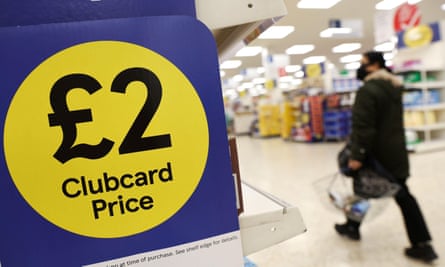
Good morning. Did you do a supermarket shop this weekend? And if so did you scan your loyalty card at the checkout? Because if you didn’t, you likely paid a few extra quid at the till.
Britain’s supermarkets have created “two tiers” of pricing – one for those that sign up to give their data to the corporations – and another sometimes considerably higher price for people who have the temerity to refuse to sign up to the schemes.
The inequity has annoyed some customers for years, and now the consumer rights group Which? is accusing some supermarkets of using “potentially dodgy tactics” to trick customers into thinking they’re getting a better deal than they really are. It’s now calling on the UK competition watchdog to launch an investigation.
For today’s newsletter, I asked Hilary Osborne, the Guardian’s money and consumer editor, and Which? lawyer Lisa Webb how we got here, and what might happen next. But first, the headlines.
Five big stories
-
Met Police | The Metropolitan police has called on the SAS to provide counter-terrorism support, after firearms officers downed their weapons in protest at the charging of their colleague for the fatal shooting of 24-year-old Chris Kaba, who was unarmed when he was killed.
-
Space | The successful return of the largest asteroid sample ever to be recovered marks the culmination of a seven-year journey in which a robotic spacecraft the size of a transit van was sent to scout out the asteroid Bennu, scoop up a sample of its pebbles and dust, and then return the samples to Earth.
-
HS2 | A prominent Conservative donor has threatened to stop supporting the party if Rishi Sunak scraps the Birmingham to Manchester leg of HS2. The donor, who asked to remain anonymous, said “recent events seriously call into question the ability to continue to support people who don’t do what they say they’d do.”
-
Kosovo | A standoff between gunmen and Kosovo authorities at a monastery near the border with Serbia ended after four people were killed. The announcement follows a chaotic day that began when a police patrol was ambushed near the village of Banjska early on Sunday.
-
AI | Concerns that criminals or terrorists could use artificial intelligence to cause mass destruction will dominate discussion at a summit of world leaders. British officials are looking to build consensus over a joint statement that would warn about the dangers of rogue actors using the technology to cause death on a large scale.
In depth: ‘Some say it’s not fair – it can add up to tens of pounds at the checkout’
 View image in fullscreenClubcard branding in a Tesco branch. Photograph: REUTERS/Alamy
View image in fullscreenClubcard branding in a Tesco branch. Photograph: REUTERS/Alamy
Tesco was the first supermarket to launch a loyalty scheme – as far back as 1995 – and now has almost 21 million people in the UK signed up to its Clubcard. Sainsbury’s has its rival Nectar card, Co-op has one, as does Iceland, Waitrose, Boots, Superdrug and Marks & Spencer, to name just a few.
The Clubcard was created by data experts Edwina Dunn and Clive Humby, founders of snappily named company Dunnhumby. When they presented their idea to Tesco’s board then-chairman Lord Ian MacLaurin reportedly said: “Well, this really worries me because you seem to know more about my business in three months than I’ve learned in 30 years.”
When they first started, loyalty cards offered customers points they could save up in exchange for trips to the cinema or – if you really saved up loads and loads – to go on holidays. In recent years many of the supermarkets have changed tactics and now offer cheaper prices at the till, but only if you have their loyalty card. At my local Tesco this morning a pepperoni pizza was £2.65 for Clubcard holders or £3.65 for Clubcard-less schmucks. The “meal deal” – sandwich, drink and snack – is 50p cheaper if you have a Clubcard. The discount (or markup, you choose which description fits best) on a Naked pineapple and passionfruit smoothie was £1.70 on the £4.20 sticker price.
“Some people say it’s just not fair, and it has created a two tier pricing” Hilary says. “There can be a huge price difference on some products that can add up to tens of pounds at the checkout. If you’re walking into Tesco now you’d be mad not to have a Clubcard.”
But some people – including me – are still refusing to get a Clubcard or other loyalty cards. Some don’t want to give their data to the corporations, while others don’t want to carry lots of cards (or download lots of apps). For others it’s an attempt to stick it to the man.
Data for discounts
Things began to change in 2020 when Tesco offered “Clubcard Prices” on hundreds of products for cardholders. The number of products included has increased ever since. Tesco CEO Ken Murphy boasted to investors earlier this year that the scheme had been a “huge success” and helped deliver “fantastic results” with more users signing up and spending more.
“We have built a powerful digital platform that puts us in prime position to take advantage of the exciting media monetisation and personalisation opportunities available to us,” he said.
Hilary says the supermarkets offer the discounts because “they really want our custom – and our data” as they are doing it primarily to get us going back. She is happy to give away her data, not just to Tesco but to seemingly any company that offers a supposed deal. As we chat, I ask her to show me how many of the cards she has on her.
There’s one for Tesco, Sainsbury’s, Morrisons, Waitrose, Ikea, Boots, Superdrug, Hobbycraft, The Works, TK Maxx, Sunshine Garden Centre (an independent shop in north London), and one for Paperchase – which might not offer the best discounts any more as the store collapsed into administration January.
“No wonder my wallet won’t fit in my pocket,” she says as she stuffs them all back in.
But are the discounts even real?
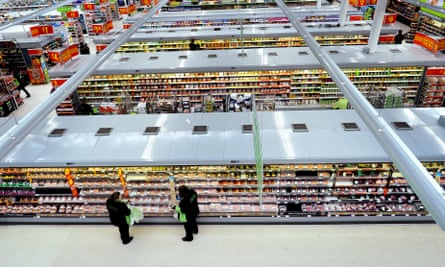 View image in fullscreenAn Asda supermarket. Photograph: WorkImages/Alamy
View image in fullscreenAn Asda supermarket. Photograph: WorkImages/Alamy
Which? reckons that even if you do shop with a Clubcard you might not be getting as much of a bargain as it appears. It claims Tesco and Sainsbury have sometimes increased the regular price just before starting loyalty promotions. Both the supermarkets deny the allegations, and criticise Which?’s “flawed methodology”.
Its researchers watched 141 Tesco Clubcard and Sainsbury’s Nectar card product prices and tracked the pricing of these products over a six month period. Which? claimed to find that only 29% of products included in member-only promotions were listed at their “so-called ‘regular price”.
Among the examples listed by Which? is a 200g jar of Nescafé Gold Blend instant coffee which it found advertised for £6 to Nectar cardholders, or £8.10 at the “regular” price. “But the regular price had also been £6 at Sainsbury’s until it went up to £8.10 just two days before the Nectar price launched,” Which? said.
At Tesco, Which? found Heinz Salad Cream (605g) with a Clubcard price of £3.50 and a regular price of £3.90. However its regular price had been £2.99 for several weeks before it was increased to £3.90 – just 22 days before the Clubcard promotion.
Lisa Webb, a lawyer for Which?, says the consumer rights group decided to carry out the research because an increasing number of customers were getting “quite vitriolic” about being ripped off or locked out of the schemes.
You must be over 18 to sign up for many of the schemes, and some require that you are resident in the UK (so tourists can’t benefit from discounts), some also require a postal address, which means homeless people are forced to pay higher prices.
“Dual pricing is kind of new territory, as previously loyalty cards had just offered points,” says Webb, who despite her concerns admits to having a Tesco Clubcard and several other loyalty cards. “We wanted to see is if they are actually a real bargain for people, or whether people without cards are getting charged more. The findings are stark, in a third of our examples the member-only promotions were at their so-called ‘regular’ price, less than 50% of the six month period.”
Which? has asked the Competition and Markets Authority (CMA) to look into the loyalty schemes. It’s the second time that Which? has complained about Tesco’s Clubcard to the regulator.
“We’re very pleased that the CMA is going to have a look at this – especially during the cost of living crisis,” says Webb.
I’ve never had any loyalty card, and I don’t intend to start. But I still get the discounts. My advice to you: screenshot a friend’s cards. I use my boyfriend’s and I hope it messes up Tesco’s analytics: he’s a vegan, and I buy steak every other visit.
What else we’ve been reading
 View image in fullscreenA woman checking out with digital payment at the counter. Photograph: bernie_photo/Getty Images
View image in fullscreenA woman checking out with digital payment at the counter. Photograph: bernie_photo/Getty Images
-
On the subject of loyalty cards, Emma Beddington writes about the icky feeling she gets from her collection: “My lust for bargains overrides the existential unease, especially when they’re really good.” Toby Moses, head of newsletters
-
Sarah Lucas, one of the most famous of the YBA artists admits to not having the hardest work ethic in this interview with Stuart Jeffries ahead of a Tate retrospective. “I remember my mum telling me not to do my homework. She said ‘School is where you do school work. Go and play.’” Lucas is grateful to her late mother. “Time is actually the only valuable thing. You need time to think rather than be making all the time. That’s when inspiration hits.” Rupert
-
“To be honest, I’m a bit hungover.” Joan Collins doesn’t disappoint in a lengthy conversation with Simon Hattenstone that takes in her career, marriages, and her refusal to fall prey to the casting couch. Toby
-
We’ve all heard of Raac, the problematic concrete that has led to dozens of schools not opening on time this term. But what is Raac – full name reinforced autoclaved aerated concrete – and where did it come from? Philip Ball has all the answers. Rupert
-
Why are so many ex-footballers emerging as devotees of conspiracy theorists? Simon Hughes writes sensitively for the Athletic about Rickie Lambert’s shift from lovable ex-Liverpool player to David Icke follower. Toby
skip past newsletter promotion
Sign up to First Edition
Free daily newsletter
Our morning email breaks down the key stories of the day, telling you what’s happening and why it matters
Enter your email address Enter your email address Sign upPrivacy Notice: Newsletters may contain info about charities, online ads, and content funded by outside parties. For more information see our Privacy Policy. We use Google reCaptcha to protect our website and the Google Privacy Policy and Terms of Service apply.
after newsletter promotion
Sport
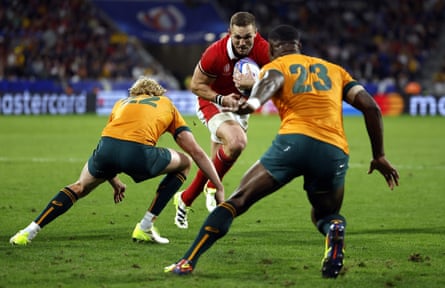 View image in fullscreenAustralia’s Carter Gordon and Wales’s George North in action during their Rugby World Cup match. Photograph: Guillaume Horcajuelo/EPA
View image in fullscreenAustralia’s Carter Gordon and Wales’s George North in action during their Rugby World Cup match. Photograph: Guillaume Horcajuelo/EPA
Football | There were eight different goalscorers at Bramall Lane, where a rampant Newcastle inflicted a record 8-0 home defeat on Sheffield United. Spurs twice came from behind to earn a 2-2 draw against Arsenal, which leaves both teams level on 14 points. Aston Villa’s Ollie Watkins piled misery on a struggling Chelsea after Malo Gusto’s red card, scoring the only goal in a 1-0 win.
Rugby | Australia is staring at an embarrassing early exit from the Rugby World Cup, having never previously failed to qualify for the knockout stages. If congratulations are clearly due to Warren Gatland’s Wales for inflicting a record 40-6 defeat on the Wallabies, this was Eddie Jones’s absolute worst nightmare.
Golf | Europe dramatically retained the Solheim Cup with a 14-14 tie against the United States after Carlota Ciganda’s crucial putt. It was a gripping contest coming down to narrowest of margins, with Ciganda holding her nerve in a match against Nelly Korda.
The front pages
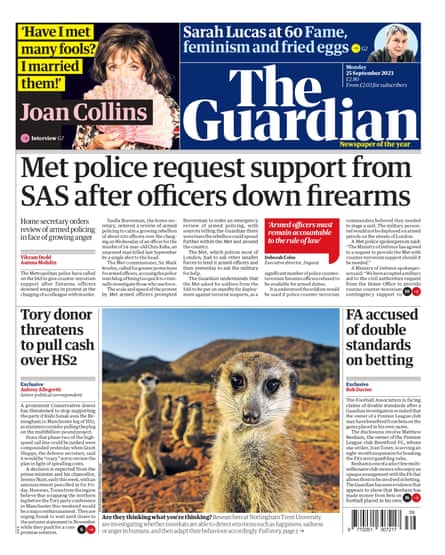 View image in fullscreen Photograph: Guardian
View image in fullscreen Photograph: Guardian
The Guardian leads with “Met police request support from SAS after officers down firearms”. The Telegraph has the same story, under the headline “Army called in as firearm officers put down guns”, while the Times says “Army on standby after revolt by police”.
The Mail reports on the prime minister’s proposed “crime crackdown”, with “Rapists barred from early release”. The Financial Times leads with “Russia gains from oil’s surge after dodging price cap”. The i has more on the government’s net zero U-turn with “Green target delay will raise cost of living, Sunak warned”.
The Mirror reports on a car crash involving Marcus Rashford under the headline “Crash Rash in rush to help”. The Sun has the same story focusing in on the cost of the England star’s car with “£700k Rash crash”.
Today in Focus
 View image in fullscreenBaltimore Ravens offensive tackle Michael Oher sits on the beach in 2010. Photograph: Nick Wass/AP
View image in fullscreenBaltimore Ravens offensive tackle Michael Oher sits on the beach in 2010. Photograph: Nick Wass/AP
The Blind Side and Hollywood’s blind spot
When Andrew Lawrence interviewed the American football player Michael Oher in 2009, Oher was already uncomfortable about how his life story was being portrayed to the public. This was shortly before The Blind Side was released, and Lawrence says the film “threatened to blow up those uncomfortable elements one hundred fold”.
The Oscar-winning film, starring Sandra Bullock, tells the story of Oher’s rise to the NFL with the support of the Tuohy family, who took him in when he was 17.
“There are many cringe-worthy scenes in that movie,” Lawrence tells Michael Safi, “but something about their elementary school-age son teaching this high school football player how to play on the offensive line using kitchen condiments on their table – it’s disgusting, frankly.”
Cartoon of the day | Edith Pritchett
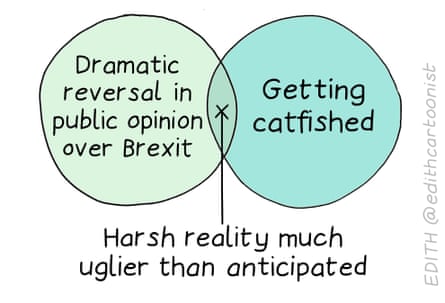 View image in fullscreen Illustration: Edith Pritchett/The Guardian
View image in fullscreen Illustration: Edith Pritchett/The Guardian
Sign up for Inside Saturday to see more of Edith Pritchett’s cartoons, the best Saturday magazine content and an exclusive look behind the scenes
The Upside
A bit of good news to remind you that the world’s not all bad
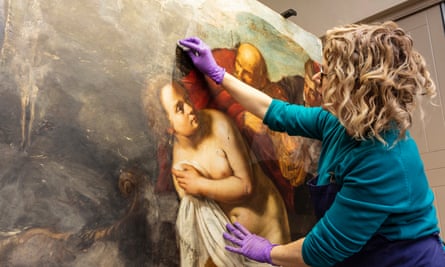 View image in fullscreenSusanna and the Elders being restored. Photograph: Royal Collection Trust/© His Majesty King Charles III 2023/PA
View image in fullscreenSusanna and the Elders being restored. Photograph: Royal Collection Trust/© His Majesty King Charles III 2023/PA
A painting by Italian baroque painter Artemisia Gentileschi has been rediscovered after being lost in a store room in Hampton Court Palace for more than 100 years. The painting Susanna and the Elders by Gentileschi, who is considered to be one of the greatest female artists of her generation, was thought to have been lost after a batch of works were dispersed across Europe after King Charles I’s was beheaded outside Banqueting House in 1649.
But Royal Collection Trust curators who were trying to trace all those paintings tracked down the Gentileschi to a royal storeroom at Hampton Court where it had been left covered in grime after being misattributed at least two centuries ago. It is now on display in Windsor Castle.
Sign up here for a weekly roundup of The Upside, sent to you every Sunday
Bored at work?
And finally, the Guardian’s puzzles are here to keep you entertained throughout the day – with plenty more on the Guardian’s Puzzles app for iOS and Android. Until tomorrow.
-
Quick crossword
-
Cryptic crossword
-
Wordiply

